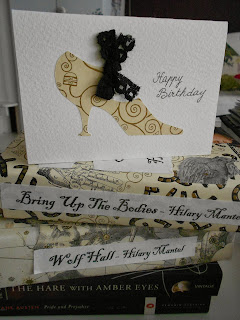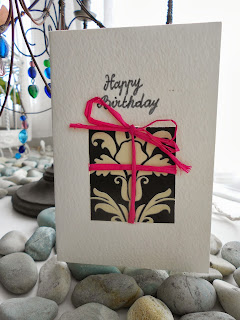I collect fabric, lace and ribbons, but also anything with an interesting print like paper. So next to my boxes of material, I have bags of rolls of paper. Combining both is an interesting challenge that many artists have met by creating items with paper usally made from fabric or vice versa.
So I have created greeting cards for all occasions which always sell well at craft fairs. The secret to make successful cards lies in the design, the theme which will appeal to all. Once you get it right, everything follows.
Then you need a range of interesting paper, ribbons, lace, buttons or anything to do with sewing. There are some interesting creations made from cutting pages of books and sewing them together in patterns. However, I am not comfortable with the idea of cutting up books, which are sacred to me. Maps can be an interesting alternative too.
You may use fabric and sew it directly onto the card with a sewing machine using large stitches. It looks lovely and very effective, but it's a lot of work. Obviously, when making commercial items, you ought to bear in mind how long it takes you to make the card and if it's worth the effort; people will not buy cards which cost beyond what they are prepared to pay for a small item.
You can leave the cards blank or write a message. For this, I use a nib and ink, but you could make a collage in a ransom-letter style, or anything you can think of.
To make cards you need:
Card, Cartridge or watercolour paper
Interesting paper, old books or maps
Lace, ribbons or small buttons
Glue
Sharp blade to insert lace or ribbon
Nib and ink
Glitter glue, sequins
You can buy these cards via my on-line Folksy shop.
 I nearly didn't go to this latest exhibition at the V&A. I was already living in London at that time and remember clothes designers used to make then well, but it wasn't my scene at all, and I hated most of it.
I nearly didn't go to this latest exhibition at the V&A. I was already living in London at that time and remember clothes designers used to make then well, but it wasn't my scene at all, and I hated most of it.
 Unlike today, fashion was still created by youth itself and young designers who were part of the club scene. It had a direct link with music, lifestyle and DIY punk ethics. However, it was very cliquey and if you didn't share the same taste in music and go to these clubs which were rather elitist, you were cast out as a dinosaur (already!) stuck in punk or worse, victim of the strong mod-skinhead 60's revival, which was my case.
Fashion was outrageous, silly, glam, unwearable and sexless. The fabrics were mostly stretch jersey, Lycra, anything shiny like vinyl or metallised. They were a lot of experimentation with painted fabrics in tribal design. Silhouettes were deconstructed, exaggerated or showing of the body never seen before. Out of these trends emerged the brilliant Body Map and their two-tone graphic designs on stretch jersey and frilly knitwear. They invented the modern silhouette with body hugging jersey tops, mini skirts and leggings. I remember buying a round vinyl shoulder bag printed with their iconic two-tone star. They have created a beautiful top based on their archives for the exhibition priced £95 you can purchase at the exhibition shop.
Unlike today, fashion was still created by youth itself and young designers who were part of the club scene. It had a direct link with music, lifestyle and DIY punk ethics. However, it was very cliquey and if you didn't share the same taste in music and go to these clubs which were rather elitist, you were cast out as a dinosaur (already!) stuck in punk or worse, victim of the strong mod-skinhead 60's revival, which was my case.
Fashion was outrageous, silly, glam, unwearable and sexless. The fabrics were mostly stretch jersey, Lycra, anything shiny like vinyl or metallised. They were a lot of experimentation with painted fabrics in tribal design. Silhouettes were deconstructed, exaggerated or showing of the body never seen before. Out of these trends emerged the brilliant Body Map and their two-tone graphic designs on stretch jersey and frilly knitwear. They invented the modern silhouette with body hugging jersey tops, mini skirts and leggings. I remember buying a round vinyl shoulder bag printed with their iconic two-tone star. They have created a beautiful top based on their archives for the exhibition priced £95 you can purchase at the exhibition shop.

 Vivienne Westwood also made an impact on the period, notably with the mini crini and the corset, which are still valid to this day. John Galliano produced his first collection and a number of well-known designers still in business are also on display. Most notably Katherine Hamnett put large political or eco slogans on T-shirts which may have been inspired by Punk but made an impact on the catwalk for the first time.
My problem with the V&A is the lack of interaction and the deadening effect of the museum environment which effectively kills all the freshness and impetuousness of those vibrant creations. The Textile and Design Museum can organise the same kind of thing ten times better. The whole thing feels stiff and contrived.
I can't help thinking that a "Tracey Emin treatment" would be more appropriate to show that kind of clothing. After all, we all used to live in squats, make clothes ourselves or buy them at Kensington Market, party in them, sit on floors, throw them on beds or at the bottom of wardrobes. They were never made to be shown in museums this way. I cannot get used to the fact that now you can only see them from afar outside the context they were meant to be worn.
Entrance fee: £5. Until 16 February 2014
http://www.vam.ac.uk/content/exhibitions/exhibition-from-club-to-catwalk-london-fashion-in-the-80s/visitor-and-ticket-information/
Vivienne Westwood also made an impact on the period, notably with the mini crini and the corset, which are still valid to this day. John Galliano produced his first collection and a number of well-known designers still in business are also on display. Most notably Katherine Hamnett put large political or eco slogans on T-shirts which may have been inspired by Punk but made an impact on the catwalk for the first time.
My problem with the V&A is the lack of interaction and the deadening effect of the museum environment which effectively kills all the freshness and impetuousness of those vibrant creations. The Textile and Design Museum can organise the same kind of thing ten times better. The whole thing feels stiff and contrived.
I can't help thinking that a "Tracey Emin treatment" would be more appropriate to show that kind of clothing. After all, we all used to live in squats, make clothes ourselves or buy them at Kensington Market, party in them, sit on floors, throw them on beds or at the bottom of wardrobes. They were never made to be shown in museums this way. I cannot get used to the fact that now you can only see them from afar outside the context they were meant to be worn.
Entrance fee: £5. Until 16 February 2014
http://www.vam.ac.uk/content/exhibitions/exhibition-from-club-to-catwalk-london-fashion-in-the-80s/visitor-and-ticket-information/






